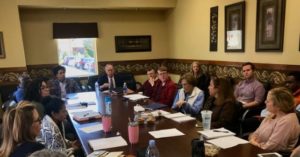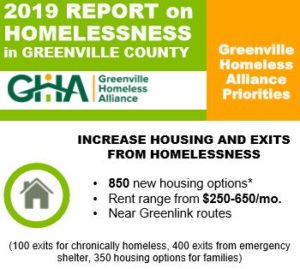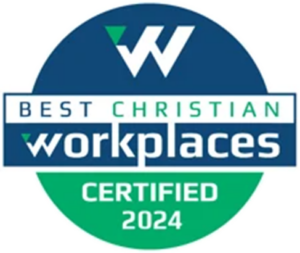
Susan McLarty, Greenville Homeless Alliance Coordinator
I want to begin by thanking Miracle Hill Ministries for the opportunity to write a blog entry. At the press conference to release the 2019 Report on Homelessness in Greenville County on Friday, November 15, 2019, Ryan Duerk, Miracle Hill’s CEO, provided opening comments, revealing the new number of 3,633 men, women and children who experienced homelessness in 2018-2019 and explaining that the largest portion of that number, 2,285, was served by emergency shelter. Thank you, Miracle Hill, for providing 60% of the emergency shelter beds. Over the past five years since the release of the 2015 Homelessness White Paper and the resulting increased collaboration among partners addressing homelessness, Miracle Hill has been leading the way, doing the work and answering the call.
When I look back at my role five years ago working for Westminster Presbyterian in Mission Outreach and Congregational Care, I reflect on the fact that I knew Miracle Hill as an organization but did not know the people working for or being served by the organization. The opportunity to meet both is one of the greatest joys I have experienced as the Greenville Homeless Alliance Coordinator. I hope the proclamation made by Greenville Mayor Knox White and Greenville County Council Chairman Butch Kirven declaring November 15, 2019 as Greenville Homeless Alliance Hunger and Homelessness Awareness Day helps our community see the impact but also recognize that the three words painted on the wall in the Greenville Rescue Mission gym, “You Are Loved”, is the key element for making homelessness brief and rare as outlined in the new 2019 report.
Shelter “Exits” Key to Ending Homelessness
3,600+ people lacked a fixed, regular or adequate nighttime residence in 2018-2019. One third of those were children. While this new number is the largest ever reported, it is still not representative of everyone.

Greenville Homeless Alliance partners meet at Greenville Rescue Mission to discuss needs and prepare strategy.
For emergency shelters to catch people new to homelessness (75% of which arrived with no income) we must recognize that once stabilized by emergency shelter many are working in jobs that are essential to our economy. Examples of jobs are listed on page 28 of the report. Men and women cannot exit emergency shelter without housing that is safe and in a rent range for their portion equaling $200 – $650 per month, and that is accessible to a Greenlink bus route. Page 18 of the report shares the 12,000 unit housing deficit and provides the housing ladder required to exit 400 people immediately. Without exits, people cannot enter emergency shelter when in crisis.
The data point for knowing how many people live unsheltered or outdoors on our streets, in a car or abandoned building is the annual one night federally-mandated count from Housing and Urban Development (HUD) called the Point in Time Count or PIT Count. In 2019, this number was 242, and 39% lived on our streets longer than a year. Homelessness causes trauma, and the longer the experience lasts often means the more costly it is to solve. However, Greenville has a proven solution that decreases the cost to taxpayers by 92% in charges to detention centers and local hospitals. You can read a story about Housing First on page 20. The Greenville Homeless Alliance is calling for 100 immediate Housing First options. Greenville is the third highest county in South Carolina for the number of people experiencing homelessness in 2019. We are number one in the state for 32,312 households who are eligible for housing assistance but are not receiving it. However, we expect in 2020 to be the first in South Carolina to announce effective zero for veterans homelessness. We believe homelessness is solvable when we all work together.
Affordable Housing Tops List of Priorities
 Children is where data shows homelessness is growing, and 90% of the families do not have access to financial resources to exit homelessness. This becomes more complex if you are a single mother with a son over the age of 10 years, a single father, or a large family. An innovative solution is emerging called, “A New Lease on Life.” You can read about this on page 26. The chart titled, “Options for Maintaining Housing Affordability” on page 15 outlines the rent ranges required for economic mobility. The story on page 7 titled, “Climb or Jump: The Financial Cliff That Can Lead to Homelessness” provides a glimpse into why housing options matter. Greenville needs 350 immediate housing options and diversion strategies for families.
Children is where data shows homelessness is growing, and 90% of the families do not have access to financial resources to exit homelessness. This becomes more complex if you are a single mother with a son over the age of 10 years, a single father, or a large family. An innovative solution is emerging called, “A New Lease on Life.” You can read about this on page 26. The chart titled, “Options for Maintaining Housing Affordability” on page 15 outlines the rent ranges required for economic mobility. The story on page 7 titled, “Climb or Jump: The Financial Cliff That Can Lead to Homelessness” provides a glimpse into why housing options matter. Greenville needs 350 immediate housing options and diversion strategies for families.
To reach the next stage of planning, we must move beyond what we have traditionally done. This must be a community-wide effort focused on consistent investment in and execution of a comprehensive strategy that measures housing opportunity, educational attainment, healthcare disparities and the physical and economic mobility of the workforce. I encourage you to join us as we move into strategic planning around five priorities:
1. Increase Housing and Exits from Homelessness
2. Reduce Barriers
3. Strengthen Coordinated Response
4. Support Transit
5. Impact Policymaking
Greenville County expects 222,000+ new residents by 2040. We know that this is both a moral and economic imperative to ensure everyone has a safe, affordable place to call home.
 Post submitted by Susan McLarty, Greenville Homeless Alliance Coordinator. Susan can be reached at 864.568.5791 or smclarty@gvlhomes4all.org
Post submitted by Susan McLarty, Greenville Homeless Alliance Coordinator. Susan can be reached at 864.568.5791 or smclarty@gvlhomes4all.org






